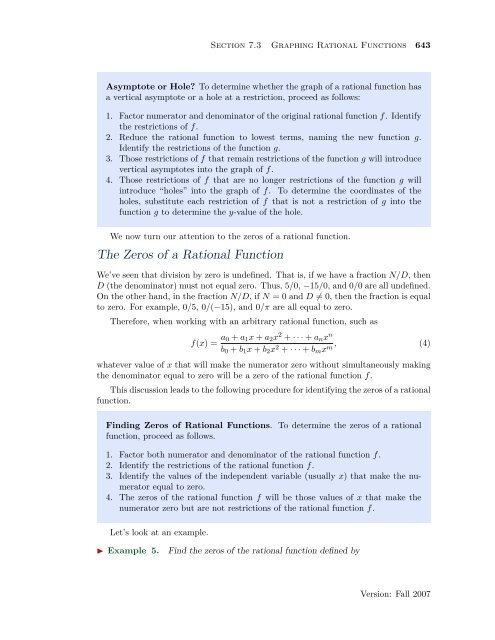Chapter 7 Rational Functions - College of the Redwoods
Chapter 7 Rational Functions - College of the Redwoods
Chapter 7 Rational Functions - College of the Redwoods
You also want an ePaper? Increase the reach of your titles
YUMPU automatically turns print PDFs into web optimized ePapers that Google loves.
Section 7.3 Graphing <strong>Rational</strong> <strong>Functions</strong> 643<br />
Asymptote or Hole? To determine whe<strong>the</strong>r <strong>the</strong> graph <strong>of</strong> a rational function has<br />
a vertical asymptote or a hole at a restriction, proceed as follows:<br />
1. Factor numerator and denominator <strong>of</strong> <strong>the</strong> original rational function f. Identify<br />
<strong>the</strong> restrictions <strong>of</strong> f.<br />
2. Reduce <strong>the</strong> rational function to lowest terms, naming <strong>the</strong> new function g.<br />
Identify <strong>the</strong> restrictions <strong>of</strong> <strong>the</strong> function g.<br />
3. Those restrictions <strong>of</strong> f that remain restrictions <strong>of</strong> <strong>the</strong> function g will introduce<br />
vertical asymptotes into <strong>the</strong> graph <strong>of</strong> f.<br />
4. Those restrictions <strong>of</strong> f that are no longer restrictions <strong>of</strong> <strong>the</strong> function g will<br />
introduce “holes” into <strong>the</strong> graph <strong>of</strong> f. To determine <strong>the</strong> coordinates <strong>of</strong> <strong>the</strong><br />
holes, substitute each restriction <strong>of</strong> f that is not a restriction <strong>of</strong> g into <strong>the</strong><br />
function g to determine <strong>the</strong> y-value <strong>of</strong> <strong>the</strong> hole.<br />
We now turn our attention to <strong>the</strong> zeros <strong>of</strong> a rational function.<br />
The Zeros <strong>of</strong> a <strong>Rational</strong> Function<br />
We’ve seen that division by zero is undefined. That is, if we have a fraction N/D, <strong>the</strong>n<br />
D (<strong>the</strong> denominator) must not equal zero. Thus, 5/0, −15/0, and 0/0 are all undefined.<br />
On <strong>the</strong> o<strong>the</strong>r hand, in <strong>the</strong> fraction N/D, if N = 0 and D ≠ 0, <strong>the</strong>n <strong>the</strong> fraction is equal<br />
to zero. For example, 0/5, 0/(−15), and 0/π are all equal to zero.<br />
Therefore, when working with an arbitrary rational function, such as<br />
f(x) = a 0 + a 1 x + a 2 x 2 + · · · + a n x n<br />
b 0 + b 1 x + b 2 x 2 + · · · + b m x m , (4)<br />
whatever value <strong>of</strong> x that will make <strong>the</strong> numerator zero without simultaneously making<br />
<strong>the</strong> denominator equal to zero will be a zero <strong>of</strong> <strong>the</strong> rational function f.<br />
This discussion leads to <strong>the</strong> following procedure for identifying <strong>the</strong> zeros <strong>of</strong> a rational<br />
function.<br />
Finding Zeros <strong>of</strong> <strong>Rational</strong> <strong>Functions</strong>. To determine <strong>the</strong> zeros <strong>of</strong> a rational<br />
function, proceed as follows.<br />
1. Factor both numerator and denominator <strong>of</strong> <strong>the</strong> rational function f.<br />
2. Identify <strong>the</strong> restrictions <strong>of</strong> <strong>the</strong> rational function f.<br />
3. Identify <strong>the</strong> values <strong>of</strong> <strong>the</strong> independent variable (usually x) that make <strong>the</strong> numerator<br />
equal to zero.<br />
4. The zeros <strong>of</strong> <strong>the</strong> rational function f will be those values <strong>of</strong> x that make <strong>the</strong><br />
numerator zero but are not restrictions <strong>of</strong> <strong>the</strong> rational function f.<br />
Let’s look at an example.<br />
◮ Example 5.<br />
Find <strong>the</strong> zeros <strong>of</strong> <strong>the</strong> rational function defined by<br />
Version: Fall 2007

















